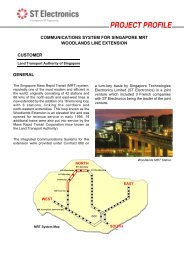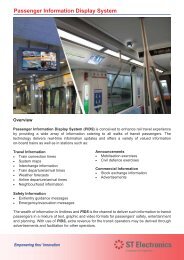The complete issue [ 36 pages | 2.38MB ] - ST Electronics
The complete issue [ 36 pages | 2.38MB ] - ST Electronics
The complete issue [ 36 pages | 2.38MB ] - ST Electronics
You also want an ePaper? Increase the reach of your titles
YUMPU automatically turns print PDFs into web optimized ePapers that Google loves.
A P P L I C A T I O NN O T E SiDirect remote power stationAdopting satellite for the smart gridBy Michel Zimet, Director Vertical Marketing, Energy and Utilities, iDirectToday, across the globe, utilitycompanies are investing in smartgrid strategies to make yesterday’selectrical grid infrastructure moreintelligent, reliable and efficientfor tomorrow. With the smart grid,utilities gain several key advantages:they can reduce costs by automatingmonitoring and managementfunctions; they can gather data inrealtime to help prevent and respondmore quickly to outages; they canactively monitor and optimise energyusage to improve efficiency; andthey can incorporate new alternativeenergy sources such as solar andwind power.While the smart grid holds thepromise of a better way to powercommunities, it requires utilitiesto rethink their communicationsinfrastructure. <strong>The</strong> communicationsnetwork that powers the grid canno longer consist of a series ofdisconnected technologies thatsupport separate functions, but ratheract as an integrated, layered andevolving system that serves a widerange of possible utility applications.Not only are the communicationsrequirements of these applicationsvaried and challenging, the geographicenvironments where they are deployed– including urban, suburban andrural areas – are equally demanding.<strong>The</strong> communications network thatsupports the smart grid must stretchacross extreme terrain, deep intoremote and rural areas, far removedfrom core operations and beyond thereach of terrestrial connectivity. Inaddition, it must do so reliably andresiliently as networking becomesmore deeply embedded within thecritical grid infrastructure.To build a communications networkcapable of supporting today’s smartgrid, utilities need to understandthe evolving performance, reliability,security and costs associated withthe various technologies availableto them. In particular, they shouldconsider one technology that hasundergone a major transformationin recent years, making it morepowerful, affordable and reliable forsupporting the smart grid satellite IPcommunications. Satellite has theability to integrate seamlessly withcore communications technologyto provide <strong>complete</strong> geographicalcoverage and stretch broadbandconnectivity to any location.Emerging RequirementsToday, utilities must addressseveral emerging communicationsrequirements for the smart grid.<strong>The</strong>y need broadband data rates tosupport more bandwidth-intensiveapplications that improve security,on-site operations and management,and access to core networks. <strong>The</strong>ymust ensure greater reliability forSCADA networks that handle datamonitoring in order to view largervolumes of data with realtime visibility.To monitor and collect data from ruralcustomers, they need ubiquitousnetwork coverage. Finally, most utilitycompanies need a way to connectunmanned remote substations to theircore operations and manage on-siteapplications and communicationsdevices remotely.Across all these trends, utilitycompanies face a common challenge.28 ELECTRONICS REVIEW


![The complete issue [ 36 pages | 2.38MB ] - ST Electronics](https://img.yumpu.com/41667250/27/500x640/the-complete-issue-36-pages-238mb-st-electronics.jpg)
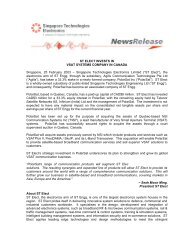
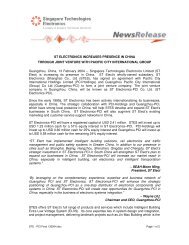
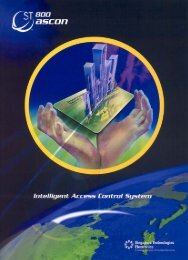




![The complete issue [ 32 pages | 2.43 MB ] - ST Electronics](https://img.yumpu.com/47270333/1/184x260/the-complete-issue-32-pages-243-mb-st-electronics.jpg?quality=85)



